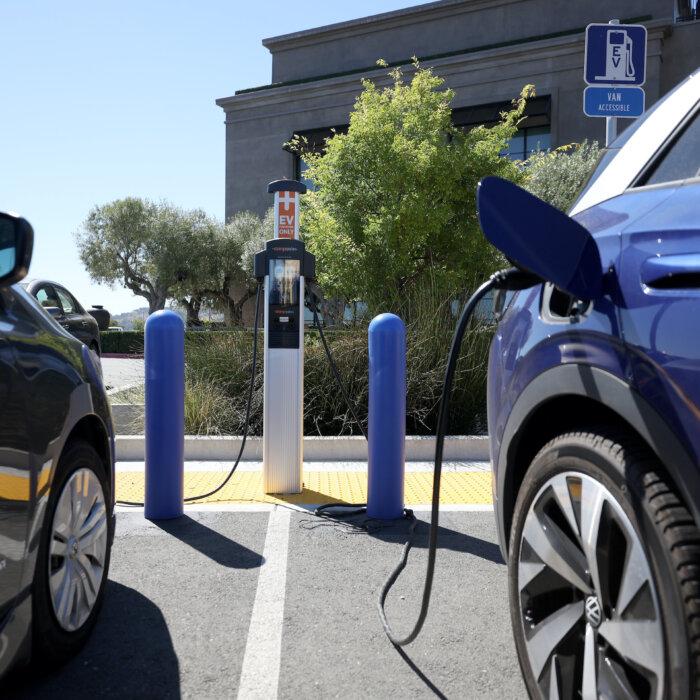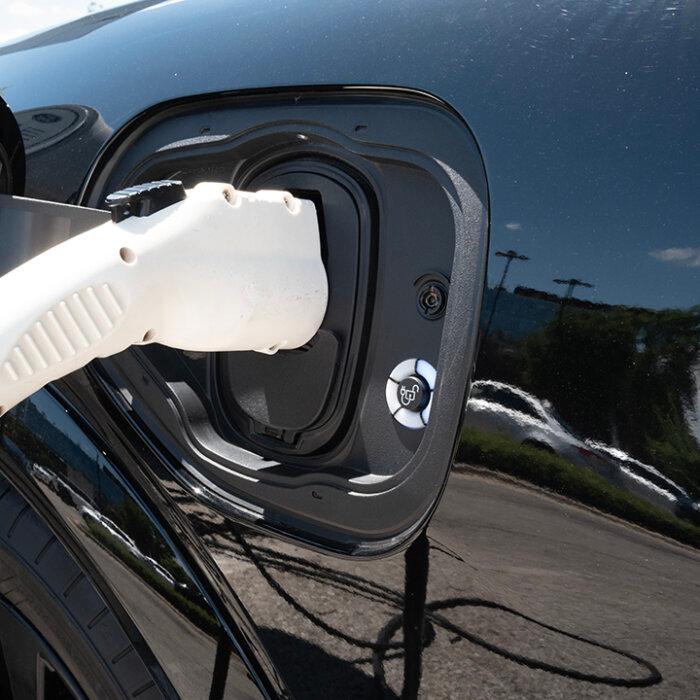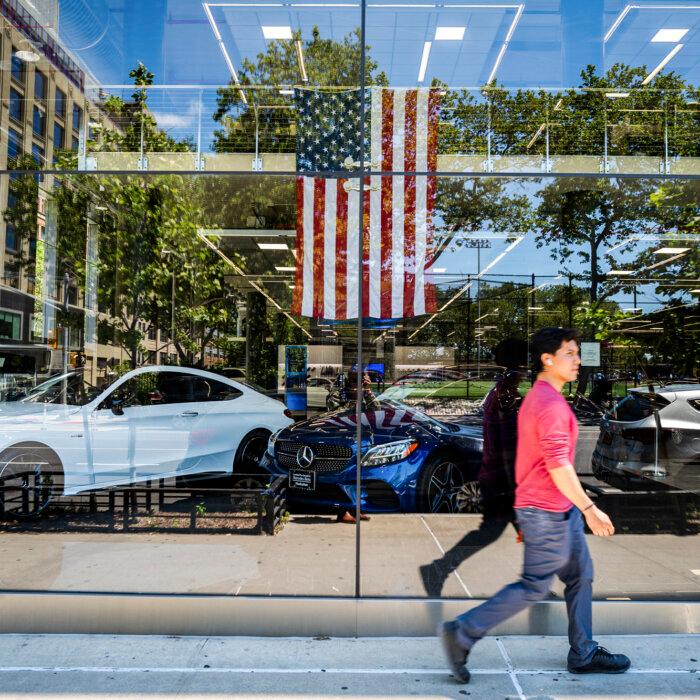Electric vehicles are slowly gaining ground in the U.S. as automakers boost their range of offerings and stricter state and federal emissions laws come into effect. However, most car buyers aren’t purchasing EVs and remain highly skeptical of the technology.
With the two major parties displaying significantly different views on EVs, the 2024 presidential election will play a significant role in determining whether the rollout will pick up speed or stall.
Over the past four years, the White House and Democrats in Congress pushed ahead with new policies aimed at increasing electric vehicle (EV) adoption in the United States.
The most consequential move, introduced in March, requires U.S. automakers and dealerships to make half of their new sales either all-electric or hybrid vehicles by 2032. Right now, the vast majority of cars sold in the country use gas-powered internal combustion engines.
After relatively brisk sales in 2020 and 2021, dealerships are having a hard time selling new EVs in 2024. Major automakers—including Ford, General Motors, and Toyota—are scaling back battery-powered EV plans altogether based on what analysts who spoke with The Epoch Times say was likely an overestimation of demand growth in North America.
Meanwhile, EV adoption is accelerating elsewhere in the world. China is currently leading the way in EV utilization and production. Industry forecasts predict global EV demand will continue to rise for years to come as the technology gets cheaper and automakers offer a wider range of EV models.
The Republican Party’s 2024 platform and its presidential candidate, former President Donald Trump, promise to roll back what they call the EV mandate if Trump is elected and the GOP gains power in Congress in 2024. The Democratic Party, which signaled its commitment to the existing energy and climate policies in its own party platform, will likely stay the course if its candidate, Vice President Kamala Harris, is elected and it wins additional seats on Capitol Hill.
A global overview of the auto industry published in March by German financial services giant Allianz Group said the presidential election “could very well be a pivotal moment for the U.S. auto industry, determining whether the momentum towards electrification continues or takes a significant detour.”
Adoption in the US
Demand for battery-powered EVs, gas-electric hybrids, and plug-in hybrids has risen sharply since 2019, according to the U.S. Energy Information Administration.
As of June, about 19 percent of all light-duty vehicles sold in the United States were EVs or hybrids. Battery-powered cars currently make up about 7 percent of overall U.S. sales.

Attendees check out the Toyota LQ and i-Road battery electric vehicles during a preview at the Washington DC Auto Show in Washington on Jan. 19, 2023. Alex Wong/Getty Images
Stephanie Valdez Streaty, director of industry insights at Cox Automotive, said 2023 was a record year for EV sales, with 1.2 million units sold. However, Cox forecasted 2024 as a year of bumps in the road.
“We’re still seeing EV demand, but it’s not at the growth [level] we’ve seen the last few years,” Valdez Streaty told The Epoch Times.
Cox Automotive is part of Cox Enterprises, an automotive industry solutions company focused on vehicle remarketing services and digital and software solutions for auto dealers. Cox Automotive owns Kelley Blue Book and Autotrader, among other assets.
Rebecca Lindland, senior director of industry data and insights at Cars Commerce, told The Epoch Times that recent market activity is more indicative of a normalization in the market.
Instead of being ordered ahead of production by eager early adopters, EVs are now on the lot alongside gas-powered internal combustion engine cars. To win the consumer’s dollar, Lindland said EVs need to compete with all other new and used vehicles in terms of price and utility.
Karl Brauer, an executive analyst at car search engine and price aggregation service iSeeCars.com, told The Epoch Times that dropping prices of new EVs and exceedingly long dwell times on dealer lots mean the EV market has reached a “saturation point.”
“There’s too much supply and not enough demand,” Brauer said. “Dealers are struggling with EVs stacking up on their lots, and they’re asking the automakers for help to sell [them].”
According to the analysts’ current research, the average price of a new EV in August was between $56,000 and $60,000. That price is unaffordable for most Americans, who budget around $30,000 to buy a car.
Brauer said it’s likely the auto industry was overly optimistic about consumers wanting to own EVs in 2024 and mistakenly overbuilt its production capacity. Now, executives at auto companies are cutting back production, canceling plans for specific products, or shifting their EV expansion timeline.
In August, Ford announced it canceled its plans for a new, battery-powered three-row SUV in order to improve its overall profitability. Going forward, the auto giant will reduce its capital expenditures on “pure electric vehicles” from 40 percent to 30 percent of its overall capital expenditures.

Ford electric trucks are displayed outside the New York Stock Exchange on March 23, 2023. Spencer Platt/Getty Images
In July, the EV market share leader Tesla told investors its automotive group saw its first half of 2024 revenue drop by $3.975 billion from 2023. It said the “lower average selling price” of its vehicles contributed to the decline.
Out of the so-called big three automakers, only Ford discloses the financial activities of its EV business. GM and Stellantis—the makers of Chrysler, Dodge, Jeep, and Ram models—do not offer a breakdown. Ford holds the second-largest share of EV sales behind Tesla, according to the Dearborn, Michigan, company.
Ford’s second-quarter earnings release, published in July, revealed that before income taxes, the Ford Model e segment lost $2.46 billion in the first half of 2024. That’s an increase from the $1.8 billion pre-tax loss Model e reported in the first half of 2023. As a whole, Ford and its subsidiaries reported a $3.16 billion profit in the first half of 2024.
Political Maneuvers
In March, the Environmental Protection Agency announced a new national pollution standard requiring most new vehicles sold in the United States to be either all-electric or hybrids by 2032. The emissions rule will begin to come into effect in the model year 2027 with stricter standards taking effect in subsequent years.
The Democratic Party platform approved during the Democratic National Convention in July takes credit for the emissions rule and the 2022 Inflation Reduction Act (IRA). It said the tax credits established by the act—which offer up to $7,500 in credits for a new EV purchase and $4,000 for a used one—“helped quadruple sales” of EVs.
According to the White House, the 2022 legislation allows the government to spend more than $17 billion on building up a network of 500,000 electric vehicle chargers, zero-emission transit and school buses, and ensuring “domestic manufacturers have the critical minerals and other components necessary to make EV batteries.”
In a May interview with CBS’s “Face the Nation,” U.S. Secretary of Transportation Pete Buttigieg said only a “handful” of chargers are currently being built. However, because of funding from IRA and other climate initiatives, the United States will hit its goal by 2030, he said.
In August, the Department of Transportation announced the distribution of $521 million in grants to create more than 9,200 EV charging stations. The grant announcement said there are currently 192,000 public EV chargers in the United States.
In August comments shared with the press, Ammar Moussa, the Harris campaign’s director of rapid response, said Harris “does not support an electric vehicle mandate.”
Nevertheless, in the Senate, Harris was a co-sponsor of the so-called Green New Deal proposed by Sen. Edward Markey (D-Mass.) in 2019. The legislation called for the mass adoption of EVs to reduce overall emissions. In an August interview with CNN, Harris said her “values have not changed” when asked about the Green New Deal.
An issues statement published on Harris’s campaign website says she “will always fight for the freedom to breathe clean air, drink clean water, and live free from the pollution that fuels the climate crisis.”
At the Republican National Convention, Trump said he “will end the [EV] mandate on day one, thereby saving the U.S. auto industry from complete obliteration, which is happening right now, and saving U.S. customers thousands and thousands of dollars per car.”


(Left) Democratic delegates attend the Democratic National Convention in Chicago on Aug. 21, 2024. (Right) Delegates listen to former President Donald Trump’s speech during the Republican National Convention in Milwaukee on July 18, 2024. Madalina Vasiliu/The Epoch Times
Crossroads
Even if Democrats prevail in November, Brauer said he believes the policies enacted to boost EV purchases will be scaled back or delayed due to the current lack of appetite for EVs among average motorists.
“If we actually think about what the American citizen does want, they clearly do not want electric vehicles at the level that they’re trying to be mandated,” Brauer said. “That is undeniable.”
If Republicans are elected, the Allianz report said Trump is likely to redirect funding currently designated for expanding EV adoption back to gas-powered vehicle manufacturing.
“International EV makers and their battery-producing partners would be less incentivized to ramp up investment in the [United States], while local automakers would further pull back from their EV investment plans,” the Allianz report said.
Valdez Streaty said the incentives offered to buyers and automakers by the IRA and similar policies are critical to making EV sales. Additionally, the made-in-America requirements written into the IRA are already pushing international automakers such as Kia Corp. and Hyundai Motor Group to build production facilities in the United States.
Lindland said Tesla CEO Elon Musk’s endorsement of Trump could soften a second Trump administration’s stance on EV-minded regulations. Musk endorsed Trump on the social media platform X in July.
Valdez Streaty and Lindland both said pulling back public investment in charging stations would undoubtedly harm the viability of EVs going forward.
All of the analysts said the biggest obstacle to adoption is the lack of public confidence in the U.S. charging network. While the number of stations is growing, according to the U.S. Department of Energy, most chargers are clustered in urban areas. There are relatively few public EV chargers compared with the ubiquitous gas station.

Electric car chargers on display during the North American International Auto Show at the Huntington Place convention center in Detroit on Sept. 14, 2023. Matthew Hatcher/AFP via Getty Images
In June, the consultancy McKinsey & Co. published a global consumer survey that concluded that 49 percent of current EV drivers in America said they plan on switching back to a gas-powered car. Among the global respondents, 35 percent said their choice was motivated by the poor public charging infrastructure, 24 said they cannot charge at home, and 21 percent said worrying about charging is “too stressful.”
Regardless of the outcome in November, for EVs to truly compete with gas-powered cars, automakers need to lower the cost of ownership, and public charging infrastructure must be improved.
“EVs have to have price parity,” Valdez Streaty said. “Consumers have to have the right product at the right price and the right experience.”
So far, Lindland said, the automakers are holding up their end of the bargain in terms of product mix. Manufacturers are rolling out battery-powered versions of trucks, SUVs, and luxury vehicles with increased range in an effort to give the buying public what they want.
Right now, as most Americans struggle to afford any car—new or used—Brauer said industry research shows the average EV driver is wealthy and owns multiple cars, including a gas-powered one.
“You can’t tell the average American, who needs value for their dollar, to buy the most expensive, least driven, highest cost-per-mile form of transportation,” Brauer said.
Original News Source Link – Epoch Times
Running For Office? Conservative Campaign Consulting – Election Day Strategies!





